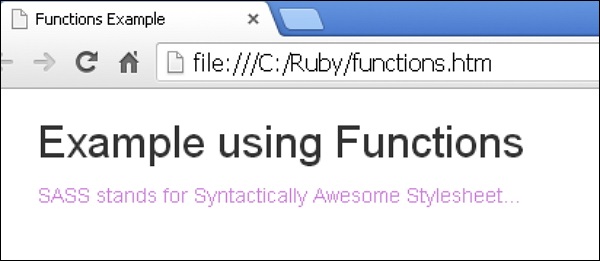
- Sass - Home
- Sass - Overview
- Sass - Installation
- Sass - Syntax
- Using Sass
- Sass - CSS Extensions
- Sass - Comments
- Sass - Script
- Sass - @-Rules and Directives
- Control Directives & Expressions
- Sass - Mixin Directives
- Sass - Function Directives
- Sass - Output Style
- Extending Sass
Sass - Functions
Description
SASS supports the use of functions by providing some keyword arguments, which are specified using normal CSS function syntax.
Syntax
p {
color: hsl($hue: 0, $saturation: 50%, $lightness: 50%);
}
HSL stands for hue, saturation, and lightness, which are more intuitive for creating a set of matching colors by using saturation and lightness.
hue − It represents the degree of color such as 120 for red, 240 for green, 290 for pastel violet etc.
saturation − It is a percentage value that increases the saturation of color.
lightness − It is a percentage value which decreases the lightness of color.
Example
The following example demonstrates the use of functions in the SCSS file −
<html>
<head>
<title>Functions Example</title>
<link rel = "stylesheet" type = "text/css" href = "style.css" />
<link rel = "stylesheet" href = "https://maxcdn.bootstrapcdn.com/bootstrap/3.3.5/css/bootstrap.min.css">
<script src = "https://ajax.googleapis.com/ajax/libs/jquery/2.1.3/jquery.min.js"></script>
<script src = "https://maxcdn.bootstrapcdn.com/bootstrap/3.3.5/js/bootstrap.min.js"></script>
</head>
<body>
<div class = "container">
<h2>Example using Functions</h2>
<p>SASS stands for Syntactically Awesome Stylesheet..</p>
</div>
</body>
</html>
Next, create file style.scss.
style.scss
Use the following SCSS code which defines the HSL function on the SASS code.
p {
color: hsl(290,60%,70%);
}
You can tell SASS to watch the file and update the CSS whenever SASS file changes, by using the following command −
sass --watch C:\ruby\lib\sass\style.scss:style.css
Next, execute the above command; it will create the style.css file automatically with the following code −
style.css
p {
color: #d185e0;
}
Output
Let us carry out the following steps to see how the above given code works −
Save the above given html code in functions.html file.
Open this HTML file in a browser, an output is displayed as shown below.
